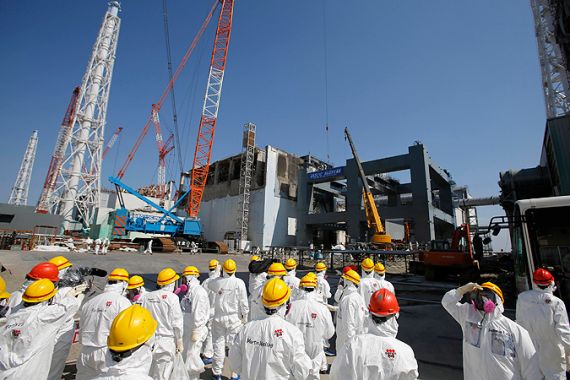Power cut strikes Fukushima nuclear plant
Storage pools at tsunami-hit Japan plant without fresh cooling water for 15 hours but officials say no immedate danger.

Engineers at Fukushima partially succeeded in restarting cooling systems after a power cut struck the tsunami-hit Fukushima nuclear plant in central Japan.
Tokyo Electric Power Company (TEPCO) said on Tuesday that four fuel storage pools at the plant had been without fresh cooling water for more than 15 hours because of the power outage.
Keep reading
list of 4 itemsWorld’s coral reefs face global bleaching crisis
Why is Germany maintaining economic ties with China?
Australia’s Great Barrier Reef suffers worst bleaching on record
The water in the pool cools the used fuel and acts as a shield to protect people and the environment from radiation.
Two of the cooling systems were back up late on Tuesday, Japanese media reports said. TEPCO said one other was likely to be online later in the day.
Kenichi Tanabe, a TEPCO spokesman, said engineers were trying to repair a broken switchboard that might have caused the problem.
“Electricity has been cut to pools used to cool spent fuel at reactors 1, 3 and 4,” Tanabe said.
He said power had also been cut to equipment used to treat contaminated discharge including radioactive caesium.
Nuclear crisis
The incident had not so far affected cooling-water injection to the number 1, 2 and 3 reactors themselves, which had core meltdowns soon after the start of the March 2011 nuclear crisis, the company said.
Tanabe said the temperatures of all fuel pools were well below the safety limit of 65 degrees Celsius (149 Fahrenheit), but they had risen by 0.3 – 0.4 degrees every hour.
The used fuel pool at reactor 4 could reach 65 degrees in four days if it continued at its present rate and if power is not restored, Tanabe said.
“We are trying to restore power by then,” Tanabe said.
TEPCO estimated it will restore power to the other two reactors in about 14 to 26 days.
Masayuki Ono, acting head of TEPCO’s nuclear power and facilities section, told a news conference on Tuesday that the warmest pool was 30.5 degrees.
“We are prioritising recovering power and restarting operations,” he said.
“But if it takes a long time we can pour cooling water whenever necessary so that the worst case scenario can be avoided.”
Tanabe said there had been no major changes in the level of radioactivity at nearby monitoring spots.
Downplaying disaster
The meltdowns of three of Fukushima’s six reactors occurred after the earthquake and ensuing huge tsunami shut off the power supply and cooling system on March 11, 2011.
TEPCO was repeatedly criticised for downplaying the scale of the disaster in the first few months and has since admitted it was aware of the potential dangers of a big tsunami, but had done nothing because of the reputational and financial cost.
The government gave its backing on Tuesday to the company’s handling of Tuesday’s power outage incident.
Chief Cabinet Secretary Yoshihide Suga said a serious crisis appeared unlikely.
“As they are planning to take all possible substitute measures for cooling we do not need to worry at all in a sense,” Suga said.
That view was echoed by Akio Koyama, professor at Kyoto University’s department of reactor safety management.
“At this point, I don’t think anything serious will occur immediately,” he said.
“The important thing is to continue injecting water to the nuclear fuel in the reactors and continue cooling used fuel in the pool.
“Even if the water temperature goes up to 65 degrees Celsius, it would not cause anything critical right away, as long as the fuel bars are covered in water.
“If the water levels get lower to the point where the fuel bars are exposed to the air, then we would have to worry.”